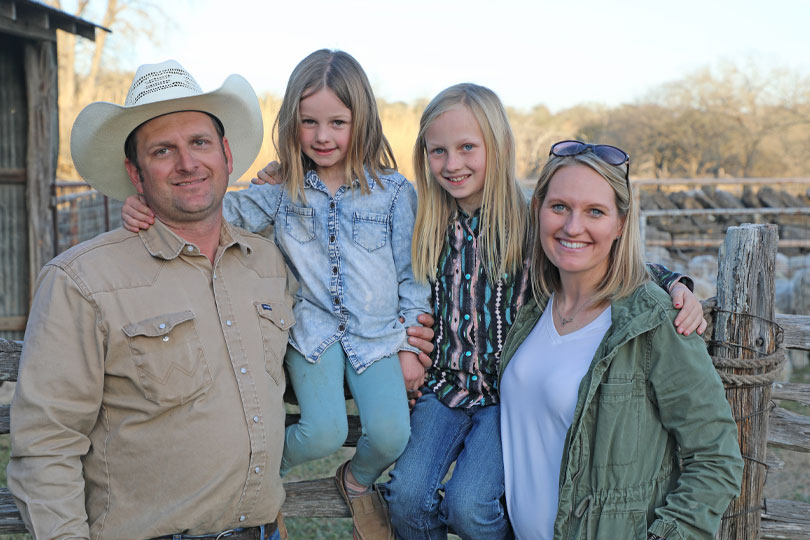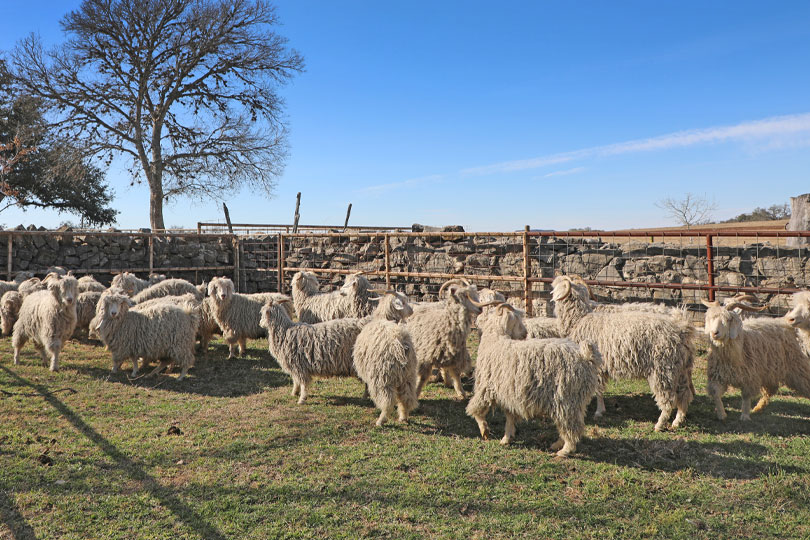By Julie Tomascik
Editor
Taking a drive through the Hill Country and West Central Texas offers more than beautiful landscapes. It shows a glimpse into the area’s unique agricultural commodity—mohair.
This luxurious, strong fiber comes from Angora goats and makes up a significant portion of the agricultural economy in the Edwards Plateau and the Hill Country. The vast majority of the nation’s herd of Angora goats is found in these regions of Texas, cared for by farmers and ranchers.
And two of those Texas producers are Kendall County Farm Bureau members Cody and Melody Kneupper.

Cody and Melody Kneupper with their two daughters.
Cody’s family has been raising Angora goats for generations.
Along with the Angoras, Cody and Melody also raise cattle, fine wool sheep, Boer goats and Spanish goats.
“Angora goats are a special breed of goats,” Melody said. “Their hair has a really unique quality that makes it a really strong fiber.”
The hair grows about an inch each month, so it’s necessary to shear them twice a year—usually in early spring and early fall.
One of the challenges of raising Angoras is finding a crew to shear the goats. The physical labor and the skills needed are reasons why crews are a dying breed.
“Typically, farmers and ranchers don’t shear their own goats. They hire shearing crews to come in. There’s a few left in this area in Texas, the Edwards Plateau, and a little further out in West Texas, there are a few shearing crews,” she said. “There’s usually five or six guys at a time that come out, and they set up in a barn or in a covered area on a clean floor.”
The shearing process requires every member of the crew to work quickly, yet carefully.
The crew sets up their equipment, including shearers that, in highly- skilled hands, can shave a mature goat in about two minutes.
One by one, goats with a full coat of mohair are moved to the shearing station.
The pace is fast.
Members of the crew begin shearing. Another person picks up the mohair and puts the product into a sack, aiming to fill the bag with as many pounds as possible.
Then, the sheared goats are turned down the alley to another pen.
“Immediately after they shear the goats, they would either grade the wool right away or send it to a warehouse and grade it there,” Melody said. “Then, at the warehouse, it sits and waits until a buyer buys it—maybe a clothing maker, carpet maker or blanket maker. They will then clean and comb the mohair.”
Ranchers, like the Kneuppers in Kendalia, help provide about 90% of the mohair grown in the United States.
From clothes to carpets, the silky-smooth fleece is a versatile, all-season fiber, appropriate for the ever-changing weather in Texas. It’s even flame-resistant and used as a decorating fabric.
And for Cody and Melody, it’s part of their livelihood.
“Shearing the goats is not much different than a cotton farmer harvesting cotton or a grain farmer harvesting grain,” Melody said. “It’s our source of income.”
It benefits the goats, too.
“Shearing doesn’t hurt the goats. It’s actually a relief to them, especially in August or September when it’s really hot,” Melody said. “It’s not painful. These animals were made to grow hair for us to be able to use, and they want it shorn off.”
But the Kneuppers closely watch the goats after they are shorn, because that is when they are most susceptible to weather conditions.
“We have to provide them cover or shelter for at least a few weeks in case it rains or gets really cold until they get about a half inch of hair back on them,” Cody said.
But mohair isn’t the only way goats help sustain a productive ranch.
They also help control weeds and brush throughout pastures, which is critical to the long-term health of the land.
“One of the biggest benefits to raising goats on your property is for brush control,” Cody said. “Without us raising goats, we would have to manage the land in a totally different aspect that would be very costly. But these goats can do it for us, and then we can benefit from that, too.”
They also handle the Texas heat well, which helps them thrive in the dry climate. Even during times of drought, the goats continue to produce a quality product.
But raising sheep and goats comes with additional challenges, namely a constant threat from predators.
Texas is home to numerous species that prey on livestock. Coyotes, bobcats, foxes, cougars and even feral hogs all take their toll on sheep and goats.
Luckily, area farmers and ranchers, in cooperation with state and federal wildlife experts, have been proactively managing the predator population.
“There’s established predator control in this area. They’ve been controlling the coyotes and foxes for many years,” Melody said. “So, we don’t have as many predators as they do in other places in the state, and the landscape, the weather and vegetation that we have here are all just really great for Angora goats.”
The challenges of raising them are no match for the satisfaction the couple has when each shearing is complete.
“It’s very rewarding being a part of production agriculture and doing our part to help feed and clothe the world,” Cody said.
Their roots are firmly planted in the Hill Country soil, continuing the tradition of raising livestock and a family on the land.
“We love this lifestyle, and Cody and I are so thankful that we get to raise our kids here on the ranch around animals, teaching them compassion and animal husbandry,” Melody said. “We do not take this opportunity for granted and realize how fortunate we are to be able to raise our children in this environment. It’s days like this working together in the barn or in the pasture and making memories with our family that are just tough to beat.”
Watch a video of the Angora goats being shorn at the Kneupper’s ranch.

